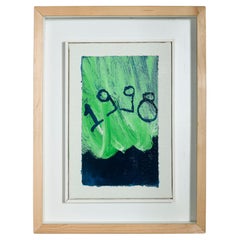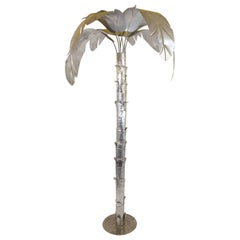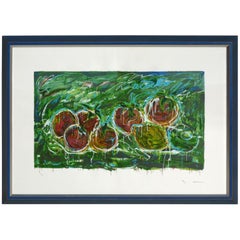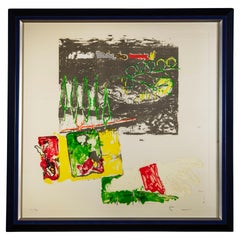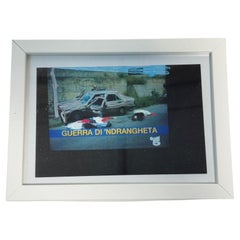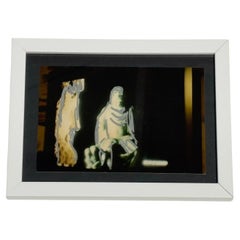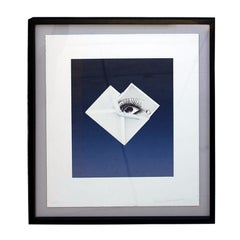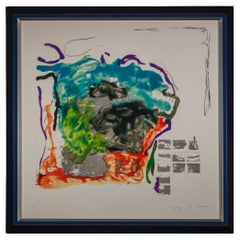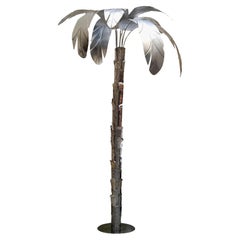Mario Schifano Furniture
Italian, 1934-1998
Mario Schifano (1934-1968) is considered one of the most significant artists of Italian postmodernism. He worked in numerous media throughout his career, but is perhaps best known for his collages consisting of advertising, scrap paper and painted components. During the latter half of his career, Schifano’s work became increasingly political as he explored issues such as the Vietnam War and widespread social unrest through both film and photography.
Born in 1934 in Libya, Schifano and his family relocated to Rome after World War II. With little interest in formal schooling, Schifano took up painting independently and began producing mixed-media works, primarily utilizing monochromatic canvases with glued wrapping paper and stenciling applied. These works garnered critical acclaim, and were followed by a number of exhibitions both in Italy and the US. In 1962 he was included in New Realists, an important group show at the Sidney Janis Gallery in New York alongside artists such as Andy Warhol and Roy Lichtenstein. Often employing elements of pop culture, such as brand logos and advertisements, his work is largely considered within the context of Pop art. Although Schifano was consistently productive and critically acclaimed, he struggled with drug addiction for most of his life, a habit that resulted in multiple arrests, which led the artist to label his career maldoto – cursed. He died at the age of 63 in Rome in 1998 (Ref: Sotheby's). His artworks have sold for over 1M€ at Sotheby's.to
8
8
5
3
8
8
1
1
6
4
4
3
2
2
8
8
8
8
8
36
7,546
3,967
2,548
2,244
Creator: Mario Schifano
1990s Signed Mario Schifano Artwork
By Mario Schifano
Located in Roma, IT
Enamel on canvas "Untitled" signature on the back.
Certification by the artist is present.
Archived in 1997 Monte Titano Arte
General Archive of Mario Schifano's paintings n. 713/97 dated 19.09.1997 Monte Titano Arte. Bibliography: the work is present in III° Mario Schifano Works on Canvas 1991-1998 page 401
The dimensions are without frame.
This painting, comes from a private collection and is beautified by an impressive original frame in natural wood, in almost perfect condition.
The painting is also protected by glass
Every item of our Gallery, upon request, is accompanied by a certificate of authenticity issued by Sabrina Egidi official Expert in Italian furniture for the Chamber of Commerce of Rome and for the Rome Civil Courts.
Mario Schifano (Homs 1934 - 1998) was an Italian painter and filmmaker.
Together with Franco Angeli and Tano Festa he represented a fundamental point of Italian and European Pop Art.
Perfectly integrated in the international cultural scene of the 1960s, he was reputed to be a prolific, exuberant and drug-addicted artist.
A keen student of new painting techniques, he was among the first to use computers to create works and was able to process images from the computer and transfer them onto emulsified canvases.
Mario Schifano was born in Italian Libya and after the end of the war returned to Rome where, due to his restless personality, he left school early to follow in his father's footsteps who worked at the Etruscan museum of Villa Giulia as an archaeologist and restorer.
Thanks to this experience, he approached art, initially producing works that were influenced by Informal Art.
His first solo exhibition was at the Galleria Appia Antica in Rome in 1959.
In the late 1950s, he participated in the artistic movement Scuola di Piazza del Popolo together with artists such as Francesco Lo Savio, Mimmo Rotella, Giuseppe Uncini, Giosetta Fioroni, Tano Festa and Franco Angeli.
The group met at Caffè Rosati, a Roman café then frequented by Pier Paolo Pasolini, Alberto Moravia and Federico Fellini, among others, and located in Piazza del Popolo, from which they took their name.
In 1960, the group's works were exhibited in a group show at Galleria La Salita.
In 1961 he exhibited in a solo show at Galleria La Tartarugadi Plinio De Martiis in Rome.
In the meantime, he had met, among others, his future lover Anita Pallenberg at the Caffè Rosati, with whom he made his first trip to New York in 1962, where he came into contact with Andy Warhol and Gerard Malanga at the Factory.
During this period he participated in the New Realists exhibition at the Sidney Janis Gallery, a group show that included most of the young artists of Pop art and Nouveau Réalisme, including Andy Warhol and Roy Lichtenstein.
He then had the opportunity to participate in the New York social scene, which led to his first experiments with LSD.[6]
On his return from New York, after participating in exhibitions in Rome, Paris and Milan, he took part in the XXXII International Art Exhibition in Venice in 1964.
During this period, his paintings defined as 'Anemic Landscapes', in which it is memory that evokes the representation of nature with small details or allusive inscriptions, and the reinterpretations of art history that later led to his famous pictorial works on futurism appear in embryo.
In Rome, he met and frequented Marco Ferreri and Giuseppe Ungaretti to whom, already in his 80s, he offered an evening at Peyote.
But one of the acquaintances of this period that most influenced him was that with Ettore Rosboch, with whom he formed a deep friendship, based on a shared passion for music. In those years, also thanks to their constant trips to London, the two became friends with the Rolling Stones, to whom they introduced Anita Pallenberg, who in 1965 began a relationship with Brian Jones, and years later became Keith Richards' partner.
In 1969, the flat in Piazza in Piscinula in Rome that then belonged to Schifano was used by Ferreri as the set for the film Dillinger is Dead, on the walls of which some of the artist's paintings can be seen.
In 1969, the Rolling Stones dedicated the song Monkey Man to Mario Schifano.
In 1971 some of his paintings were included by Achille Bonito Oliva in the exhibition Vitalità nel negativo nell'arte italiana 1960/70.
Many of his works, the so-called 'monochromes', present only one or two colours, applied on wrapping paper glued on canvas.
The influence of Jasper Johns was manifested in the use of numbers or isolated letters of the alphabet, but in Schifano's way of painting analogies can be traced to the work of Robert Rauschenberg.
In a painting from 1960, one can read the word 'no' painted with drips of colour in large capital letters, as in a wall graffiti.
The influence of Pop art can be seen in all the artistic production of Mario Schifano, who was fascinated by new technologies, advertising, music, photography and experimentation.
In particular, the artist's closest works to Pop Art are those of the 1980s.
Among the most important works of this period are the Propagande, a series dedicated to advertising brands (Coca-Cola and Esso) in which we have a clear example of the conveyance of commonly used and easily recognisable images quoted in multiple ways or details of them, bicycles, flowers and nature in general (among the most famous series are the Paesaggi anemici, Vedute interrotte, L'albero della vita...
Category
1990s Italian Mid-Century Modern Mario Schifano Furniture
Materials
Canvas, Glass, Wood
Sculpture "Costruzioni Di Oasi", Design Mario Schifano, Italy 1979
By Mario Schifano
Located in Napoli, IT
Sculpture "Costruzioni di Oasi", designed and produced by Mario Schifano in 1979.
These sculptures were made in 100 pieces; the one for sale is numero 55 as per the engraving on the...
Category
1970s Italian Mid-Century Modern Vintage Mario Schifano Furniture
Materials
Iron
Mario Schifano "Acerbi" Materic Serigraph with frame
By Mario Schifano
Located in Brescia, IT
Mario Schifano
"Acerbi"
Year: 1990s
Medium: Materic serigraph
Edition: 99/199
Frame size: 110 x 80 x 5 cm
Signed and numbered.
Category
1990s Italian Modern Mario Schifano Furniture
Materials
Wood, Paper
1980s Signed Mario Schifano Artwork on Paper
By Mario Schifano
Located in Roma, IT
Materic silkscreen print “Ondate di gelo” (Frost Waves) by Mario Schifano.
Signature and numbering in pencil on front side.
Dry stamp of the artist on front.
Edition F.C. (Not for sale) 23/30. Framed work.
The artwork for sale is part of the collection 'Best Seller: 31 graphic works by Mario Schifano' edited by Edizioni Torcular Edition on handmade paper with Torcular watermark by Cartiera Magnani of Pescia Printer: Egiziano Piersantini
This artwork, never before on the market, comes from a private collection and is beautified by an impressive original frame in natural wood, in almost perfect condition.
The painting is also protected by glass
Every item of our Gallery, upon request, is accompanied by a certificate of authenticity issued by Sabrina Egidi official Expert in Italian furniture for the Chamber of Commerce of Rome and for the Rome Civil Courts.
Mario Schifano (Homs 1934 - 1998) was an Italian painter and filmmaker.
Together with Franco Angeli and Tano Festa he represented a fundamental point of Italian and European Pop Art.
Perfectly integrated in the international cultural scene of the 1960s, he was reputed to be a prolific, exuberant and drug-addicted artist.
A keen student of new painting techniques, he was among the first to use computers to create works and was able to process images from the computer and transfer them onto emulsified canvases.
Mario Schifano was born in Italian Libya and after the end of the war returned to Rome where, due to his restless personality, he left school early to follow in his father's footsteps who worked at the Etruscan museum of Villa Giulia as an archaeologist and restorer.
Thanks to this experience, he approached art, initially producing works that were influenced by Informal Art.
His first solo exhibition was at the Galleria Appia Antica in Rome in 1959.
In the late 1950s, he participated in the artistic movement Scuola di Piazza del Popolo together with artists such as Francesco Lo Savio, Mimmo Rotella, Giuseppe Uncini, Giosetta Fioroni, Tano Festa and Franco Angeli.
The group met at Caffè Rosati, a Roman café then frequented by Pier Paolo Pasolini, Alberto Moravia and Federico Fellini, among others, and located in Piazza del Popolo, from which they took their name.
In 1960, the group's works were exhibited in a group show at Galleria La Salita.
In 1961 he exhibited in a solo show at Galleria La Tartarugadi Plinio De Martiis in Rome.
In the meantime, he had met, among others, his future lover Anita Pallenberg at the Caffè Rosati, with whom he made his first trip to New York in 1962, where he came into contact with Andy Warhol and Gerard Malanga at the Factory.
During this period he participated in the New Realists exhibition at the Sidney Janis Gallery, a group show that included most of the young artists of Pop art and Nouveau Réalisme, including Andy Warhol and Roy Lichtenstein.
He then had the opportunity to participate in the New York social scene, which led to his first experiments with LSD.[6]
On his return from New York, after participating in exhibitions in Rome, Paris and Milan, he took part in the XXXII International Art Exhibition in Venice in 1964.
During this period, his paintings defined as 'Anemic Landscapes', in which it is memory that evokes the representation of nature with small details or allusive inscriptions, and the reinterpretations of art history that later led to his famous pictorial works on futurism appear in embryo.
In Rome, he met and frequented Marco Ferreri and Giuseppe Ungaretti to whom, already in his 80s, he offered an evening at Peyote.
But one of the acquaintances of this period that most influenced him was that with Ettore Rosboch, with whom he formed a deep friendship, based on a shared passion for music. In those years, also thanks to their constant trips to London, the two became friends with the Rolling Stones, to whom they introduced Anita Pallenberg, who in 1965 began a relationship with Brian Jones, and years later became Keith Richards' partner.
In 1969, the flat in Piazza in Piscinula in Rome that then belonged to Schifano was used by Ferreri as the set for the film Dillinger is Dead, on the walls of which some of the artist's paintings can be seen.
In 1969, the Rolling Stones dedicated the song Monkey Man to Mario Schifano.
In 1971 some of his paintings were included by Achille Bonito Oliva in the exhibition Vitalità nel negativo nell'arte italiana 1960/70.
Many of his works, the so-called 'monochromes', present only one or two colours, applied on wrapping paper glued on canvas.
The influence of Jasper Johns was manifested in the use of numbers or isolated letters of the alphabet, but in Schifano's way of painting analogies can be traced to the work of Robert Rauschenberg.
In a painting from 1960, one can read the word 'no' painted with drips of colour in large capital letters, as in a wall graffiti.
The influence of Pop art can be seen in all the artistic production of Mario Schifano, who was fascinated by new technologies, advertising, music, photography and experimentation.
In particular, the artist's closest works to Pop Art are those of the 1980s.
Among the most important works of this period are the Propagande, a series dedicated to advertising brands (Coca-Cola and Esso) in which we have a clear example of the conveyance of commonly used and easily recognisable images quoted in multiple ways or details of them, bicycles, flowers and nature in general (among the most famous series are the Paesaggi anemici, Vedute interrotte, L'albero della vita...
Category
1980s Italian Mid-Century Modern Vintage Mario Schifano Furniture
Materials
Canvas, Glass, Wood
Hand-retouched Photograph by Mario Schifano
By Mario Schifano
Located in Milan, Italy
Without title mixed technique on photograph by Mario Schifano made in 1990-97.
Inscription on the back: signature "Schifano"
With certificate of authenticity. Unique piece.
Biograp...
Category
1990s Italian Modern Mario Schifano Furniture
Materials
Acrylic
Hand-retouched Photograph by Mario Schifano
By Mario Schifano
Located in Milan, Italy
Without title mixed technique on photograph by Mario Schifano made in 1990-97.
Inscription on the back: signature "Schifano"
With certificate of authenticity.
Biography
In the early...
Category
1990s Italian Modern Mario Schifano Furniture
Materials
Acrylic
Hand-retouched Photograph by Mario Schifano
By Mario Schifano
Located in Milan, Italy
Without title mixed technique on photograph by Mario Schifano made in 1990-97.
Inscription on the back: signature "Schifano"
With certificate of authenticity. Unique piece.
Biograp...
Category
1990s Italian Modern Mario Schifano Furniture
Materials
Acrylic
Hand-retouched Photograph by Mario Schifano
By Mario Schifano
Located in Milan, Italy
Without title mixed technique on photograph by Mario Schifano made in 1990-97.
Inscription on the back: signature "Schifano"
With certificate of authenticity. Unique piece.
Biograp...
Category
1990s Italian Modern Mario Schifano Furniture
Materials
Acrylic
Related Items
Abstract Black Ceramic Sculpture, Signed 1979
Located in San Juan Capistrano, CA
This abstract sculpture has a smooth black, glossy surface and an organic modernist form. The sculpture has a negative space that pierces through its center creating a sense of depth...
Category
1970s Mid-Century Modern Vintage Mario Schifano Furniture
Materials
Ceramic
Surrealist Framed Print by Bruce Richards
By Bruce Richards
Located in Los Angeles, CA
Surrealist framed print by Bruce Richards (American, born 1948):
"Witness (Man Ray)". Numbered 2/45 and signed Bruce Richards '92.
Category
20th Century American Mario Schifano Furniture
Materials
Ink, Paper
Framed Lithograph Landscape with View of the Lake and Boats Signed
By Henri Martin
Located in Miami, FL
A very colorful lithograph professionally framed, signed.
This interesting work of art is attributed to Bernard Gatner.
Will enhance any space.
Measures: 26 1/8" H x 33 5/8" W x 1...
Category
20th Century French Mario Schifano Furniture
Materials
Paper
Will Barnet Signed Limited Edition Serigraph Print "Madame Butterfly"
By Will Barnet
Located in Studio City, CA
A tranquil, gorgeously composed, quite large limited edition print by American artist Will Barnet. The print is pencil signed, titled, dated (1980) and numbered (256/300) by the artist. This is one of Barnet's most sought after images. Clearly, a standout work.
The print has been professionally framed.
Framed dimensions: 30" H, 45.5" W, 1.75" D
Barnet studied at the Boston Museum of Fine Arts School and then at the Art Students League in New York. He is the recipient of the following awards:
Artist's Lifetime Achievement Award Medal
The College Art Association’s Lifetime Achievement Award
The Philadelphia Academy of Fine Art’s Lippincott Prize
The American Academy and Institute of Arts and Letters’ Childe Hassam Prize.
His work can be found in many permanent collections including:
Albright-Knox Art Gallery
Art Institute of Chicago
Corcoran Gallery of Art
Solomon R. Guggenheim Museum
Metropolitan Museum of Art
Museum of Modern Art
Museum of Fine Art, Boston
National Gallery of Art
Phillips...
Category
1980s American Modern Vintage Mario Schifano Furniture
Materials
Paper
Op-Art Artist Anne Youkeles New Perspective Signed 3-D Serigraph Collage, 1971
By Anne Youkeles
Located in St. Louis, MO
Anne Youkeles (Austrian/American b. 1920) Op-Art Artist 3-D Geometric Serigraph Collage titled "New Perspective" signed, number 43/210 and dated 1971. In fine condition, not examined...
Category
1970s American Mid-Century Modern Vintage Mario Schifano Furniture
Materials
Glass, Wood, Paper
H 18.13 in W 16.94 in D 1.75 in
1979 Arnaldo Pomodoro Tecno Art Abstract Italian Design Sculpture Medal
By Arnaldo Pomodoro
Located in Brescia, IT
Arnaldo Pomodoro
Johnson Foundry, Milan
1979
Gilded Bronze
Ed. 344/600
Excellent Condiction
Category
1970s Italian Modern Vintage Mario Schifano Furniture
Materials
Bronze
H 0.32 in W 2.45 in D 1.97 in
Howard Behrens Limited Edition Large Scale Hillside at Fira Signed Serigraph
By Howard Behrens
Located in Topeka, KS
Fabulous vintage Howard Behrens original large-scale limited-edition hand-signed “Hillside at Fira” fine art serigraph on paper #246 of 250. Beautiful condition, keeping in mind that this is vintage and not new so will have signs of use and wear. There was a nick in the lower left side of frame that we have filled and touched up. Please see photos and zoom in for details. We attempt to portray any imperfections. Circa, 1988.
Fira Santorini, Greece… WOW!! If you’ve never been there, you’re about to feel as though you have. Howard Behrens has managed to preserve the magnificent, picturesque atmosphere and breathtaking scenic views of Fira Santorini Greece in this phenomenal original large-scale hand-signed limited edition fine art serigraph on paper called “Hillside at Fira.” This is #246 of 250 which was professionally matted and framed and is waiting to grace your home with fabulous panoramic cliffside views and charming hillside archeology from the island of Greece. At 44 x 53 this serigraph is large scale and the depth and detail in the buildings and distant mountains pulls you in… You’re standing on the edge of the hillside… you can feel the breeze in your hair, the warm sun on your face, and you can smell the salty air coming off the beach below. The tide is rolling in. Can’t you hear the crashing of the waves against the huge rocks and boulders in the distance? Fira Santorini is enchanting, relaxing, and a geographical treasure. Wouldn’t it be wonderful to travel in time...
Category
1980s American Modern Vintage Mario Schifano Furniture
Materials
Wood, Paper
H 53 in W 44 in D 1.375 in
Selection of Modernist Art Lithographs or Serigraphs
By (after) Alexander Calder, (after) Henri Matisse, Victor Vasarely, Claude and Francois-Xavier Lalanne
Located in Atlanta, GA
Selection of modernist art serigraphs or lithographs, circa 1950s-1970s.
They are:
1) Victor Vasarely color lithograph, circa 1960s. It has been recently reframed in a clean lined bl...
Category
1960s American Mid-Century Modern Vintage Mario Schifano Furniture
Materials
Glass, Paper, Wood
Italian Bronze 'Puti Di Mare' Merman Sculpture
Located in Hamilton, Ontario
Italian bronze 'Puti Di Mare' merman sculpture.
Early 19th century on Sodalite Plinth.
Category
Early 19th Century Italian Antique Mario Schifano Furniture
Materials
Bronze
Abstract Black Ceramic Sculpture, Signed 1979
Located in San Juan Capistrano, CA
This abstract sculpture has a smooth black, glossy surface and an organic modernist form. The shape is fluid and curved, resembling a stylized human form or a natural element. The da...
Category
1970s Unknown Mid-Century Modern Vintage Mario Schifano Furniture
Materials
Ceramic
Rare 50th Anniversary Dr. Seuss Grinch at Mount Crumpit Serigraph Custom Framed
By Dr. Seuss (Theodore Geisel)
Located in Tustin, CA
Very collectible and rare, sold out limited edition 50th Anniversary of How the Grinch Stole Christmas, Dr. Seuss “Grinch at Mount Crumpit” serigraph on coventry rag paper.
This ...
Category
21st Century and Contemporary American Other Mario Schifano Furniture
Materials
Paper
H 60.5 in W 31 in D 2 in
Mid-Century Colorful Geometric Artwork, Signed 1969
By James Koenig, Frank Stella, Victor Vasarely, Eva Hesse
Located in Raleigh, NC
Geometric hard lined artwork, signed 1969. This piece of art is a vibrant geometric abstraction, featuring a series of concentric rectangles that create a tunnel-like effect. The com...
Category
1960s American Mid-Century Modern Vintage Mario Schifano Furniture
Materials
Canvas, Acrylic, Paint
Previously Available Items
1980s Signed Mario Schifano Artwork on Paper
By Mario Schifano
Located in Roma, IT
“Vedute interrotte” Interrupted Views, 1988/1989
Lithograph with silkscreen interventions
70x70 cm
Signature in pencil on front
Artist's embossed stamp on the front
Bibliography
1989 Mario Schifano. Best seller, edited by Giuseppe Bonini with introduction by Achille Bonito Oliva, Torcular Edizioni, snp, rep. 26
Notes
Artwork part of the collection ‘Best Seller: 31 graphic works by Mario Schifano’ edited by Edizioni Torcular
Edition on handmade paper with Torcular watermark by Cartiera Magnani of Pescia
Printer: Egiziano Piersantini
Total edition of 331 copies (200 in Arabic numerals, 50 in Roman numerals, 21 in letters of the alphabet, 30 artist's proofs and 30 out of print)
This etching, never before on the market, comes from a private collection and is beautified by an impressive original frame in natural wood, in almost perfect condition.
The artwork is also protected by glass
Every item of our Gallery, upon request, is accompanied by a certificate of authenticity issued by Sabrina Egidi official Expert in Italian furniture for the Chamber of Commerce of Rome and for the Rome Civil Courts.
Mario Schifano (Homs 1934 - 1998) was an Italian painter and filmmaker.
Together with Franco Angeli and Tano Festa he represented a fundamental point of Italian and European Pop Art.
Perfectly integrated in the international cultural scene of the 1960s, he was reputed to be a prolific, exuberant and drug-addicted artist.
A keen student of new painting techniques, he was among the first to use computers to create works and was able to process images from the computer and transfer them onto emulsified canvases.
Mario Schifano was born in Italian Libya and after the end of the war returned to Rome where, due to his restless personality, he left school early to follow in his father's footsteps who worked at the Etruscan museum of Villa Giulia as an archaeologist and restorer.
Thanks to this experience, he approached art, initially producing works that were influenced by Informal Art.
His first solo exhibition was at the Galleria Appia Antica in Rome in 1959.
In the late 1950s, he participated in the artistic movement Scuola di Piazza del Popolo together with artists such as Francesco Lo Savio, Mimmo Rotella, Giuseppe Uncini, Giosetta Fioroni, Tano Festa and Franco Angeli.
The group met at Caffè Rosati, a Roman café then frequented by Pier Paolo Pasolini, Alberto Moravia and Federico Fellini, among others, and located in Piazza del Popolo, from which they took their name.
In 1960, the group's works were exhibited in a group show at Galleria La Salita.
In 1961 he exhibited in a solo show at Galleria La Tartarugadi Plinio De Martiis in Rome.
In the meantime, he had met, among others, his future lover Anita Pallenberg at the Caffè Rosati, with whom he made his first trip to New York in 1962, where he came into contact with Andy Warhol and Gerard Malanga at the Factory.
During this period he participated in the New Realists exhibition at the Sidney Janis Gallery, a group show that included most of the young artists of Pop art and Nouveau Réalisme, including Andy Warhol and Roy Lichtenstein.
He then had the opportunity to participate in the New York social scene, which led to his first experiments with LSD.[6]
On his return from New York, after participating in exhibitions in Rome, Paris and Milan, he took part in the XXXII International Art Exhibition in Venice in 1964.
During this period, his paintings defined as 'Anemic Landscapes', in which it is memory that evokes the representation of nature with small details or allusive inscriptions, and the reinterpretations of art history that later led to his famous pictorial works on futurism appear in embryo.
In Rome, he met and frequented Marco Ferreri and Giuseppe Ungaretti to whom, already in his 80s, he offered an evening at Peyote.
But one of the acquaintances of this period that most influenced him was that with Ettore Rosboch, with whom he formed a deep friendship, based on a shared passion for music. In those years, also thanks to their constant trips to London, the two became friends with the Rolling Stones, to whom they introduced Anita Pallenberg, who in 1965 began a relationship with Brian Jones, and years later became Keith Richards' partner.
In 1969, the flat in Piazza in Piscinula in Rome that then belonged to Schifano was used by Ferreri as the set for the film Dillinger is Dead, on the walls of which some of the artist's paintings can be seen.
In 1969, the Rolling Stones dedicated the song Monkey Man to Mario Schifano.
In 1971 some of his paintings were included by Achille Bonito Oliva in the exhibition Vitalità nel negativo nell'arte italiana 1960/70.
Many of his works, the so-called 'monochromes', present only one or two colours, applied on wrapping paper glued on canvas.
The influence of Jasper Johns was manifested in the use of numbers or isolated letters of the alphabet, but in Schifano's way of painting analogies can be traced to the work of Robert Rauschenberg.
In a painting from 1960, one can read the word 'no' painted with drips of colour in large capital letters, as in a wall graffiti.
The influence of Pop art can be seen in all the artistic production of Mario Schifano, who was fascinated by new technologies, advertising, music, photography and experimentation.
In particular, the artist's closest works to Pop Art are those of the 1980s.
Among the most important works of this period are the Propagande, a series dedicated to advertising brands (Coca-Cola and Esso) in which we have a clear example of the conveyance of commonly used and easily recognisable images quoted in multiple ways or details of them, bicycles, flowers and nature in general (among the most famous series are the Paesaggi anemici, Vedute interrotte, L'albero della vita...
Category
1980s Italian Mid-Century Modern Vintage Mario Schifano Furniture
Materials
Glass, Wood, Paper
Mario Schifano Palm Tree Sculpture "Per Costruzione di Oasi", Italy 1979
By Mario Schifano
Located in Naples, IT
A sculpture entitled 'Per Costruzione di Oasi' (By Construction of Oasis) by the famous artist Mario Schifano, best known for his paintings, many of which depict palm trees as their ...
Category
1970s Italian Mid-Century Modern Vintage Mario Schifano Furniture
Materials
Metal
Mario Schifano "Desert" Materic Serigraph with Frame
By Mario Schifano
Located in Brescia, IT
Mario Schifano
"Desert"
Year: 1990s
Medium: Materic serigraph
Edition: 75/199
Frame size: 95 x 95 x 5 cm
Signed and numbered.
Category
1990s Italian Modern Mario Schifano Furniture
Materials
Wood, Paper
Mario Schifano furniture for sale on 1stDibs.
Mario Schifano furniture are available for sale on 1stDibs. These distinctive items are frequently made of wood and are designed with extraordinary care. There are many options to choose from in our collection of Mario Schifano furniture, although gray editions of this piece are particularly popular. Many of the original furniture by Mario Schifano were created in the modern style in italy during the late 20th century. If you’re looking for additional options, many customers also consider furniture by Giorgio De Chirico, Sandro Chia, and Carmelo Cappello. Prices for Mario Schifano furniture can differ depending upon size, time period and other attributes — on 1stDibs, these items begin at $1,677 and can go as high as $12,205, while a piece like these, on average, fetch $6,941.
